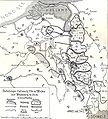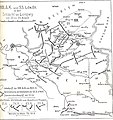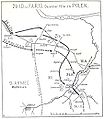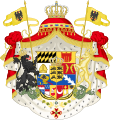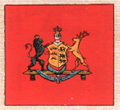Grenadier Regiment "Queen Olga" (1st Württembergisches) No. 119
|
Grenadier Regiment "Queen Olga" (1st Württembergisches) No. 119 |
|
|---|---|
| active | 1806 to 1919 |
| Country |
|
| Armed forces | Württemberg Army |
| Branch of service | infantry |
| Type | Infantry Regiment |
| structure | See outline |
| Insinuation | XIII. (Royal Württemberg) Army Corps |
| Location | See garrisons |
| march | Presentation march: "March of the Swabian District Regiment Baden-Durlach" (AI, 48) Parade march: March of the Elisabethers, also called speed march based on motifs from "Quadrilles" (A II, 28) |
| management | |
| Commanders | See list of commanders |
The Grenadier Regiment "Queen Olga" (1st Württembergisches) No. 119 was from 1806 to 1919 a regiment of the Württemberg Army . The regiment was named Queen Olga after the Russian Grand Duchess Olga Nikolaevna Romanova, the wife of King Karl I.
history
Surname
The regiment was set up in 1806 as Schröder's infantry regiment and consisted of the musketeer battalions of Mylius and Prince Paul . In the following years it was named after its owners in accordance with the custom of the time and was called the Phull Infantry Regiment in 1806 and the Prince Paul Infantry Regiment in 1809 . In 1810 it was given regiment number 1. During the Russian campaign in 1812 , the regiment was completely wiped out. In 1813 it was reorganized with a strength of approx. 30 officers and 1,400 NCOs and men in two battalions and, through the change of ownership to King Friedrich, it was converted to Leib-Infanterie-Regiment No. 1 .
With the military reform of 1817, the 1st Battalion ( Grenadier Battalion) of the Württemberg Guard Regiment was incorporated into the regiment on foot . The name Leibregiment was dropped and from March 31, 1817 the regiment was simply called 1st Infantry Regiment . The names of some regiments were only extended by a decree of King Charles on December 19, 1864 and the 1st regiment was named Queen Olga .
After the military convention with the North German Confederation of 21./25. On November 2, 1870, the regiment, like all Wuerttemberg troops, was given the designation 1. Wuerttemberg Infantry Regiment Queen Olga to distinguish it from the troops of other German states . On December 18, 1871, all regiments received additional numbers. These corresponded to the consecutive numbering of all regiments of the German Armed Forces , regardless of their affiliation to one of the contingents. The 1st Württemberg regiment received the number 119 and was qualified as a grenadier regiment by adding a name. The final spelling and numbering on December 14, 1874 was: Grenadier Regiment Queen Olga (1st Württembergisches) No. 119 .
The tradition of the regiment in the Reichswehr was taken over by the 1st and 2nd companies of the 13th (Württemberg) Infantry Regiment .
Garrisons
- 1806: Stuttgart
- 1851: Ludwigsburg
- 1859: Stuttgart
- 1865–1868: 2nd Jäger Battalion Ulm
Participation in skirmishes and combat operations
- 1806 on the side of France against Prussia , strength 4 companies with around 800 men. The regiment fought in front of Glogau , Schweidnitz and Neisse .
- 1809 on the side of France against Austria , strength 29 officers and around 1,400 men. The regiment fought near Linz and on the Pfenningberg .
- 1812 on the French side against Russia in the Ney Army Corps , around 1,400 men. After the Battle of Borodino , the remnants of the Württemberg infantry were formed into 3 battalions. In January 1813 the regiment was still 4 officers, 3 NCOs and 14 men. However, all flags were returned.
- 1813 on the side of France against Russia / Prussia in IV Army Corps Bertrand , strength around 1,400 men. After the Battle of Dennewitz , the remnants of the Württemberg infantry were formed into 3 battalions. All flags have been returned.
- the regiment did not take part in the campaigns in 1814 and 1815.
- In 1848 the regiment was used to fight unrest in the country. One platoon was involved in the battle near Dossenbach .
- 1866 against Prussia , strength 39 officers and ensigns, 10 companies. The regiment fought near Tauberbischofsheim , and three men were killed. 46 were wounded and 6 captured.
- 1870/1871 against France . With a strength of 28 officers and 1,845 NCOs and men, the regiment belonged to the Württemberg Division in the 3rd Army and fought at Champigny (October 21) and Villiers (November 30 and December 2), losses 188 dead, 367 wounded, 78 prisoners.
First World War
The regiment mobilized on August 2, 1914 and was deployed on various fronts throughout the war . The XIII. (Royal Wuerttemberg) Army Corps initially fought in the Argonne . From December 1, 1914, the 26th Division (1st Royal Württembergische) and the 25th Reserve Division (with subordinate Württemberg Field Artillery Regiment 132) formed the XIII. Corps with the 9th Army ( Mackensen ), in Poland and advanced to the Bzura near Kozlow . In March 1915 the XIII. Army corps subordinated to the 12th Army ( Gallwitz ) and relocated north to Przasnysz. From July to August she was involved in the breakthrough over the Narew and reached the Nyemen . In September the division was detached from the Eastern Front and relocated to the west of Belgrade by rail. On November 1, she was the XXII. Reserve Corps (Falkenhayn), 3rd Austrian-Hungarian. Army ( Köveß ), subordinated and advanced to Kraljevo by mid-November . In December the XIII. Army Corps with the 26th Infantry Division and the field artillery regiment "King Karl" (1st Württembergisches) No. 13 relocated to the western front in the area west of Ypres . In 1916 the regiment was used as part of the division in the Battle of the Somme .
In 1917 the division was used in the Battle of Arras and in the Second Battle of Flanders . From September 12th she was relocated from Zabern to the Klagenfurt area, where she arrived on October 7th, with the 200th Division to the General Command z. b. V. (for special use) 51 and equipped and trained for combat in the mountains. From October 24th, the division took part in the fighting in Veneto ( Twelfth Isonzo Battle and First Piave Battle ) and reached the Piave , where it remained until December 6th. She was then transferred to the Molsheim area for training behind the front and came to Valenciennes in March 1918 . During the German spring offensive in 1918 , the division advanced to Beaumont in Operation Michael and was then used at Reims . In the fighting against retreat, she went back to the Antwerp-Maas position , from where, after the Armistice of Compiègne , she marched back on foot via Prüm , Linz on the Rhine and Ferndorf to the Marburg area . From there the regiment reached its peace garrisons in Stuttgart, where demobilization took place from December 19, 1918 .
The total casualties amounted to 3,530 dead and 8,757 wounded.
Whereabouts
In January 1919 parts were transferred to the Württemberg security companies and in February 1919 to the Haas volunteer department. These went into the Reichswehr-Schützen-Regiments 25 and 26 in June 1919.
Battle of Longwy 1914
assignment
The regiment had the order to lead the infantry fire fight. In peacetime, the soldiers were trained to use appropriate weapons and as patient carriers.
organization
Association membership
Until 1816 there were no major associations in Württemberg during peace . Such were only put together for individual campaigns.
With the fundamental reorganization in 1817, the Württemberg army was divided into large units for the first time in peacetime. Together with the 2nd Infantry Regiment, the regiment formed the 1st Brigade in the 1st Division . In July 1849 a reorganization of the Württemberg army was ordered again. The infantry was grouped into just one division (without a number).
From 1871 to 1914 the regiment belonged to the 51st Infantry Brigade (1st Royal Württemberg) in Ulm , ( 26th Division (1st Royal Württemberg) , XIII (Royal Württemberg) Army Corps , 5th Army ).
In the First World War , the peace structure initially remained. When reclassified in December 1914, the 26th (Württemberg) Infantry Division remained with the XIII. Corps ("Korps Fabeck") in the 9th Army ( Mackensen ). In October 1917 she was assigned to the General Command z. b. V. (for special use) 51 in Italy, from 1918 it belonged to the 17th Army.
structure
Until 1871 the regiment consisted of two battalions .
On November 15, 1871, the 2nd Jäger Battalion came to the regiment as a fusilier battalion, on October 2, 1893, the 4th Battalion was set up.
Levies
- On October 1, 1872, the 7th Company for the formation of the III. Battalion Infantry Regiment "Alt-Württemberg" (3rd Württembergisches) No. 121 surrendered.
- In 1873 a company was set up for the III. Battalion Fusilier Regiment "Emperor Franz Josef of Austria, King of Hungary" (4th Württembergisches) No. 122 surrendered.
- On April 1, the IV (half) battalion was transferred to the 10th Württemberg Infantry Regiment No. 180 .
All of these taxes were re-established from the regiment
Armament and equipment
Main armament
Rifles with a percussion lock were introduced in 1831, the Minié rifle in 1851 , and the 98 carbine from 1898 . At the beginning of the First World War each infantry regiment had 6 heavy machine guns , at the end of 1917 36 heavy and 72 light machine guns .
uniform
- 1806: Closed blue skirt to the waist with yellow collar, lapels , borders and armpit flaps . White cloth pants and black shoes and leggings . Black caterpillar helmet with a high black neck on the front of the caterpillar, in front a yellow shield with the Württemberg coat of arms.
- 1813: Skirt as before, but white braids on the collar and lapels, black leather shako, brass plate and yellow scale chains.
- 1817: Service skirt in the months of November to April a royal blue kutka (up to an inch above the kneecap) with a blue sash , in the months of May to October a royal blue Spenzer (up to the hips), without buttons, with a closed blue collar with red piping and red lapels. Iron epaulettes with a silver crescent and blue cloth lining. Black collar. Royal blue, half-width trousers (white trousers and gaiters in summer). Black shako made of felt with leather cover, in front an iron shield with regimental number and black and red cockade. Black waist shoes (from 1820 short black gaiters and shoes). The leather gear (worn under the epaulettes) was white. Light gray coat.
- 1821: Royal blue Colett with two rows of yellow buttons (with regimental number) in front, red closed collar and blue Polish lapels with red piping. Blue pants with red piping.
- 1845: Black French shako with a white upper edge and dark blue bush.
- 1849: Single-breasted blue tunic with white buttons and red collar. Armpit flaps with regimental number.
- 1864: Dark blue, red lined skirt with two rows of white buttons, four buttons on the back, sleeves with red piping, white flaps on the collar , red shoulder flaps with shoulder bulges and black regimental number. Dark gray trousers with red piping. Dark blue hats with red piping. The epaulettes are omitted, as badges of rank stars on the collar as in Austria.
- 1871: Prussian helmet ( spiked hood ) with Württemberg coat of arms and the motto "Fearless and trew"
- 1872: Uniform according to Prussian standards, but still a double-breasted tunic until 1892. Red armpit flaps with a crowned "O". The Swedish cut serves were also retained as a distinguishing feature . The regiment had guard status and, like the 123rd Grenadier Regiment, wore white guard braid and a white plume for parades.
- 1897: In addition to the Württemberg state cockade , the German Reich cockade is now worn on the helmet, as is the case with the entire Reichsheer.
banner
The regiment received its first four flags by royal order of May 26, 1811. The cloth was yellow with golden fringes on all sides. On one side was the golden crowned signature "FR", on the other side the crowned Württemberg coat of arms with coat of arms . Like all Württemberg flags, these were brought back from the Russian campaign in 1812. As with all regiments, on October 4, 1818, the flags were replaced by standards, which were replaced by new flags by the Supreme Order of September 3, 1851. Each battalion received a flag made of burgundy-red cloth with white fringes on all sides. In the middle of one side was the gold and yellow crowned name “W”, the other side the Württemberg coat of arms held by a yellow deer and a black lion, the inscription “Feartlos und trew” on a blue foreign exchange ribbon and the white cross of the Order of Military Merit .
The Fusilier Battalion received its flag in 1874. It was like the flags from 1851, but without a fringe and with the crowned signature "K". It was replaced by the same one in 1908, but with the crowned signature "W".
The IV Battalion received its flag in 1894. It corresponded to that of the Fusilier Battalion of 1908, but with the name "WR", remained with the regiment when the battalion was surrendered and was carried by the 1st Battalion as a second flag.
Commanders
| No. | Surname | Beginning of the appointment | Remarks |
|---|---|---|---|
| 1. | Lieutenant Colonel Ludwig Wilhelm von Koseritz | October 30, 1803 | until 1806 battalion commander |
| 2. | Lieutenant Colonel Wilhelm Karl Friedrich von Nettelhorst | December 21, 1807 | |
| 3. | Colonel Rudolph von Bünau | September 4, 1808 | |
| 4th | Colonel Heinrich Constantin Franz von Dernbach | February 5, 1812 | |
| 5. | Colonel Peter Paul von Biberstein | March 23, 1803 | |
| 6th | Lieutenant Colonel Christian Alexander von Stumpe | November 1813 | . |
| 7th | Colonel Louis von Hohenlohe-Langenburg | January 1, 1814 | later commander of the 2nd Infantry Brigigade |
| 8th. | Johann Carl Christoph Kechler von Schwandorf | January 22, 1815 | |
| 9. | Colonel Louis of Valois | September 7, 1829 | later commander of the 2nd Infantry Brigade |
| 10. | Colonel Karl von Knoerzer | March 5, 1838 | |
| 11. | Colonel Wilhelm von Donop | July 11, 1848 | later commander of the 1st Infantry Brigade |
| 12. | Lieutenant Colonel Otto Paul von Seeger | January 23, 1854 | |
| 13. | Colonel Adolf von Starkloff | October 16, 1865 | later commander of the 2nd Infantry Brigade |
| 14th | Colonel Karl von Berger | April 24, 1869 | 30 November 1870 killed at Villiers |
| 15th | Colonel Karl von Knoerzer | January 10, 1871 | later commander of the 52nd Infantry Brigade |
| 16. | Colonel Ernst Pergler von Perglas | April 3, 1874 | |
| 17th | Colonel Gustav von Brandenstein | July 6, 1874 | later commander of the 52nd Infantry Brigade |
| 18th | Colonel Christian Faber du Faur | June 18, 1879 | |
| 19th | Colonel Max Schott von Schottenstein | July 9, 1883 | later Württemberg Minister of War and Prime Minister |
| 20th | Colonel Wilhelm von Pfaff | July 25, 1888 | later commander of the 39th Infantry Brigade |
| 21st | (Prussian.) Colonel Günther von Schlotheim | September 16, 1889 | later commander of the 51st Infantry Brigade |
| 22nd | Colonel Fritz von Hiller | May 25, 1892 | later commander of the 21st Infantry Brigade |
| 23. | Colonel Albrecht of Württemberg | April 18, 1896 | 1900 Commander of the 51st Infantry Brigade 1908/13 Commanding General of the XII. Army Corps 1914 Commander-in-Chief of the 4th Army |
| 24. | Colonel Alexander von Normann | September 10, 1898 | later commander of the 42nd Infantry Brigade |
| 25th | Colonel Rudolf von Berger | April 22, 1900 | 1904 Commander of the Infantry Brigade |
| 26th | Colonel Franz von Midnight | April 24, 1904 | 1907 commander of the 53rd Infantry Brigade |
| 27. | Colonel Theodor von Watter | April 14, 1907 | later commander of the 29th Infantry Brigade April 1912 to August 1914 commander of the 39th division August 1916 to December 1918 commanding general of the XIII. Army Corps |
| 28. | Colonel Karl von Graevenitz | March 24, 1909 | later commander of the 29th Infantry Brigade |
| 29 | Colonel Friedrich Bronsart von Schellendorf | October 1, 1912 | later Chief of the General Staff of the Ottoman Army |
| 30th | (Prussian.) Colonel Hans von der Esch | December 8, 1913 | later commander of the 7th Division |
| 31. | Major General z. D. Adolf von Martin | December 8, 1914 | † December 11, 1914 from his injuries |
| 32. | Colonel Karl Ströhlin | January 25, 1915 | 1917 Commander of the 53rd Infantry Brigade |
| 33. | Colonel Max von Gemmingen | June 21, 1917 | 1918 Commander of the 51st Infantry Brigade |
| 34. | Alfred Wald | January 18, 1918 | |
| 35. | Lieutenant Colonel Adolf Schwab | January 1 to September 1919 |
Regimental commander:
- 1866: Captain von Knoerzer of the 1st Jäger Battalion
- 1870/1871: Captain Schickhardt, Major von Haldenwang, Lieutenant Colonel von Schroeder
- 1914–1918: Captain Sprösser, Schwab, Freiherr von Hügel, Wolff, von Haldenwang, crowd guard
Heads of regiments
Regiment owners or regiment chiefs were
- 1805: Major General Caspar Heinrich von Schröder
- 1807: Major General Friedrich von Phull
- 1809: Lieutenant General Prince Paul of Württemberg
- December 8, 1813: King Friedrich I of Württemberg
- December 19, 1864: Queen Olga of Württemberg
- January 25, 1914: Colonel General , later Field Marshal Duke Albrecht von Württemberg
Others
- In 1895 the 7th Company won the King's Prize.
Personalities in the regiment
- General of the Infantry Hermann Geyer joined the regiment on July 4, 1900 in Stuttgart as a flagjunker .
- Philipp Albrecht Duke of Württemberg
- Hermann Stenner , painter and graphic artist
- Friedrich von Graevenitz , called "Fritz", (later) general
- Fritz von Graevenitz , sculptor, painter and university professor, son of the previous one
References
swell
- Main State Archives Stuttgart : holdings M 90, M 660/038 Bü 90 and 91
Web links
literature
- von Niedhammer: History of the Grenadier Regiment Queen Olga (1.Württ.) No. 119. Stuttgart 1886.
- von Pfister: History of the 1 Württemberg Infantry Regiment. Stuttgart 1875.
- von Haldenwang: Honor roll of the Grenadier Regiment Queen Olga (1.Württ.) No. 119. Stuttgart 1927. ( Digitized version of the Württemberg State Library )
- Max Freiherr von Gemmingen-Guttenberg-Fürfeld: The Grenadier Regiment Queen Olga (1.Württ.) No. 119 in the World War 1914–1918. Belser, Stuttgart 1927. (Volume 39 of the series The Württemberg Regiments in World War I , digitally available at urn : nbn: de: bsz: 24-digibib-bsz4080098294 )
- Günther Voigt: Germany's armies until 1918. Volume 4. Biblio, Osnabrück 1982, ISBN 3-7648-1285-0 .
- Leo Ignaz von Stadlinger, History of the Württemberg Warfare. Guttenberg, Stuttgart 1856.
- Hans-Joachim Harder: Military history handbook Baden-Württemberg. Edited by the Military History Research Office . Kohlhammer , Stuttgart 1987, ISBN 3-17-009856-X .
- Uniform regulations for the Royal Wuerttemberg Military. Royal Court and Chancellery Printing House Gebrüder Mäntler, Stuttgart 1818.
Remarks
- ↑ Württ. Government Gazette 1811 Nro. 25, June 1, page 265: “With the intention of reviving the previously established establishment of naming the cavalry and infantry regiments, at the same time also to honor and reward excellent military services in a special way, I think Moved me to dispose of the following: ... 2. I want my name to the 1st cavalry regiment and the 5th infantry regiment, and the name of my wife, the queen, to the 4th cavalry regiment and the 1st infantry regiment Olga, Majesty and Libden. "
- ↑ Württ. Lieutenant General Albert von Berrer , died October 28, 1917, successor in Württ . Lieutenant General Eberhard von Hofacker
- ↑ The regiment captured around 12,000 men and captured u. a. 44 cannons, 400 machine guns, 100 trucks and 527 other vehicles and 800 horses.
- ↑ Jürgen Kraus: Handbook of the Associations and Troops of the German Army 1914–1918 Part VI: Infantry Volume 1: Infanterie-Regimenter, Verlag Militaria, Vienna 2007, ISBN 978-3-902526-14-4 , p. 201
- ↑ Capitain von Valois had the poles burned, the strongest grenadiers wore the scarves wrapped around their bodies.
- ↑ A simple “von” in the name means personal nobility, which was conferred on every officer from Staff Captain / Staff Captain by royal order of December 12, 1806 .
- ↑ A regimental leader actually led the regiment (in the absence or after the death of the commander), but without having been officially appointed commander.




